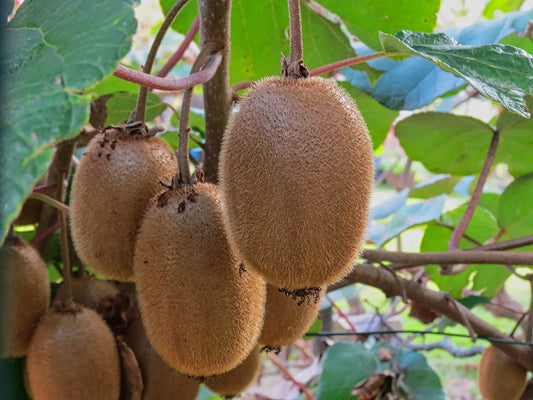You can find all our planting advice for kiwis in France here.
How profitable is kiwi production in France?
Planting / Harvesting Calendar:
Kiwi Planting and Harvesting Calendar
Production schedule for a one-hectare plot of kiwi
Self-fertile / Male Female
What is a self-fertile plant? Our self-fertile kiwi plants
What is a Male/Female plant? Our Male/Female Kiwi plants (Dioecious plants)
Kiwi Pollination - How to Promote It?
Free Plants, Grafted Plants, Rootstocks:
Kiwi - Rootstock or Free Plants: How to Choose?
Kiwi Rootstock Comparison: Bounty 71 vs Roki
Kiwi Grafting Techniques for Professionals
Plot layout / Planting technique
T-bar Method: The T-bar Method: A Complete Guide to Planting Kiwis in France
Pergola Method: The Pergola Method: A Complete Guide to Planting Kiwis in France
Fertilization / manuring of kiwi from planting to production
Kiwi Bud Break - Guide to Successful Kiwi Bud Break
Lignification - Optimizing lignification / Heightening of kiwis
Kiwi Pruning - How to Optimize Kiwi Pruning in France for Exceptional Fruit Production
Kiwi Plants In Vitro - Micro Propagation of Kiwi Plants
Kiwi - Thinning Kiwis. Why and When to Do It?
When and how to harvest kiwis?
Irrigation / Antifreeze System
Kiwi Irrigation - Water Needs of Kiwi Farms in Southern France
Antifreeze System - Antifreeze spray for kiwis: an essential solution for professional producers
Diseases that can affect kiwi crops in France
Fighting Kiwi Bacterial Canker: Symptoms, Prevention, and Professional Solutions
Fighting Kiwi Botrytis: Symptoms, Prevention and Professional Solutions
Fighting Kiwi Phytophthora: Symptoms, Prevention and Professional Solutions
Fighting Sooty Leaf and Fly Dropping Disease in Kiwi Crops: Symptoms, Prevention and Professional Solutions
Fighting Kiwi Scab: Symptoms, Prevention and Professional Solutions
Fighting Kiwi Anthracnose: Symptoms, Prevention and Professional Solutions
Fighting Kiwi Chlorosis: Symptoms, Prevention and Professional Solutions
Fighting Phaeomoniella in Kiwis: Symptoms, Prevention and Professional Solutions
Pests that can affect kiwi crops in France
Fighting the Kiwi Brown Stink Bug: Symptoms, Prevention and Professional Solutions
Fighting Kiwi Mealybug: Symptoms, Prevention and Professional Solutions
Fighting the Voracious Kiwi Mealybug: Symptoms, Prevention and Professional Solutions
Fighting the Kiwi Leafhopper: Symptoms, Prevention and Professional Solutions
Fighting Kiwi Thrips: Symptoms, Prevention and Professional Solutions
Controlling Root Knot Nematodes in Kiwi: Symptoms, Prevention and Professional Solutions

